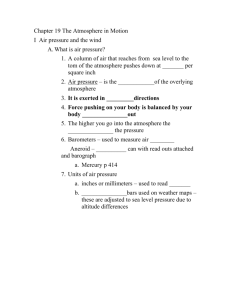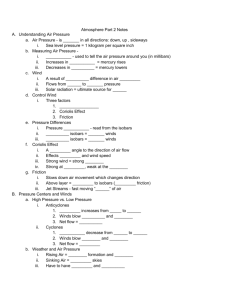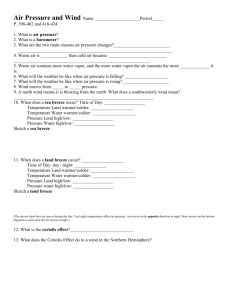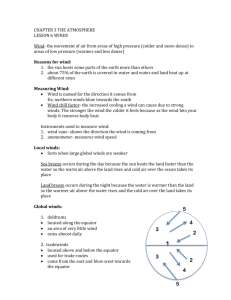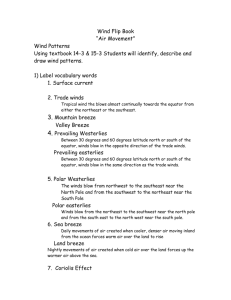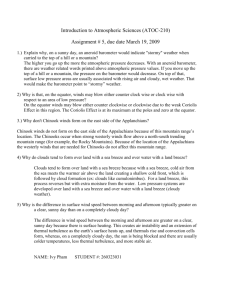Chapter 19 The Atmosphere in Motion
advertisement
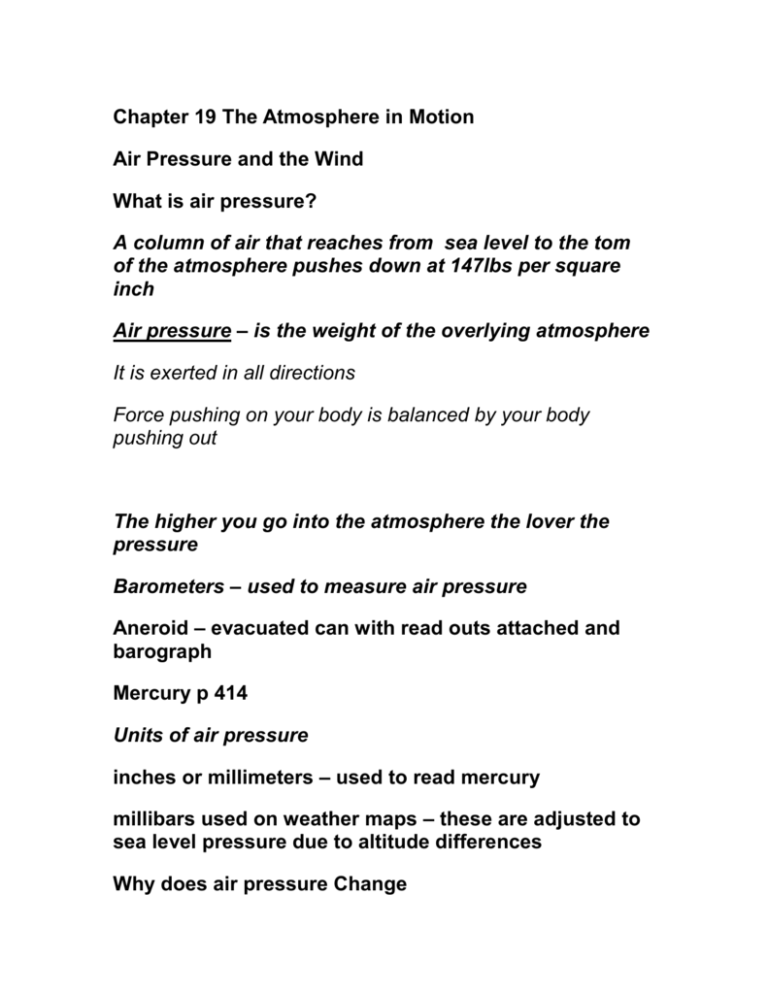
Chapter 19 The Atmosphere in Motion Air Pressure and the Wind What is air pressure? A column of air that reaches from sea level to the tom of the atmosphere pushes down at 147lbs per square inch Air pressure – is the weight of the overlying atmosphere It is exerted in all directions Force pushing on your body is balanced by your body pushing out The higher you go into the atmosphere the lover the pressure Barometers – used to measure air pressure Aneroid – evacuated can with read outs attached and barograph Mercury p 414 Units of air pressure inches or millimeters – used to read mercury millibars used on weather maps – these are adjusted to sea level pressure due to altitude differences Why does air pressure Change Elevation – higher up less air pressure Temperature – the warmer (more spread out) the less Air P. Water Vapor – the more water vapor the lower the A.P. – H2O molecules weigh less than the N & O molecules in the air Isobars – lines of equal pressure – closed isobar forms a closed lop on a map If pressure increases toward center it is a High Pressure Center Low pressure center – pressure is lower Pressure Gradient – how close the isobars are. Close together – large gradient What makes the wind blow Difference in A.P. – the greater the difference the faster the winds. The closer the isobars the faster the wind A wind blows form High P. to low P. e.g. Hot air on an island rises (form L.P.) Cool air from the water (H.P) rushes in, this is known as a sea breeze Measuring surface wind direction and speed. Wind vane – measure the direction from which the wind is blowing – Winds are named by the direction they come from e.g. westerly or sea breeze Anemometer – measure wind speed Factors affecting Wind Coriolis Effect If the earth did not spin and was perfectly smooth air would flow strait from high pressure areas(poles) directly to low pressure areas(equator) Coriolis effect causes objects traveling freely over the earth to curve In n. hemisphere curve right In s. hemisphere curve left The effect is greater near the poles The effect is also greater in long diastase travel vs. short travel The effect increases with increased speed Friction – with the earth’s surface slows winds down. The smooth surface(water) the faster wind can blow the higher coriolis effect The coriolis effect is a strong factor in determining wind direction as is a Pressure gradient speed Coriolis causes winds to blow counter clockwise in a low, clockwise in high Jet stream – swift winds due to low friction – direct path of storms Global Wind Patterns Non rotating earth would allow warm air to rise at the equator, move to the poles and sink to travel back to the equator, resulting in large circulation cell The coriolis effect (Rotation of earth) prevents this from happening 3 cell circulation model Weakness of 3Celled model gives simplified view of circulation between 30 and 60 No effect given to continents or season Simplifies upper level winds B. Description of Wind and Pressure Belts ITCZ (intertropical convergence zone) occurs at the equator hot and humid with little or no wind rain is common historically been called the doldrums Between 20 and 35 air sinks forming subtropical highs, location of earth’s deserts. Known as horse latitudes Between the doldrums and the horse latitudes are the easterly trade winds Warm and steady (speed and direction) winds Continental and Local Winds Effects of Seasons and continents Seasons, land masses and topography causes winds to vary from global patterns depicted in the 3cell model Hot air above land in summer creates low-pressure. Cold air above oceans in summer creates high pressure e.g. Atlantic Highs bring winds off the ocean into the eastern sea board. Winter is reversed Monsoons – winds caused by seasonal pressure changes Local winds – extent 100 km or less include sea breeze, land breeze, mountain breeze and valley breeze Sea – land breeze - During day land is warmer creating low pressure above` causes the cool air(H) to blowing from the water (sea) and night it reverse Mountain Breeze – at night the air against the mountain cools more than the surround air and sinks down hill Valley breeze – mountain heats the air causing it to rise and the air from the valley flows up hill

